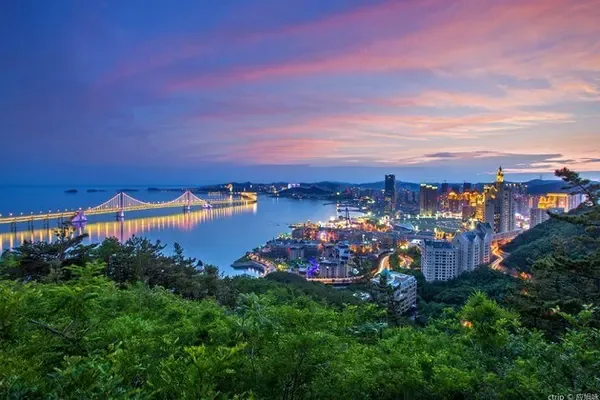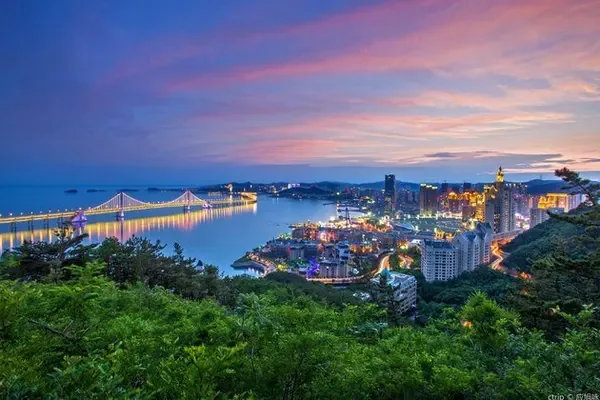It took about 2 hours to drive from Beijing to Qingwa Water Village in Sangyuan Town, Huailai. It was already noon when we arrived, and the car was parked in the courtyard of the restaurant. There were no trees in the yard, and several domestic dogs lay on the ground basking in the sun as if nothing had happened, completely indifferent to our arrival. There is a wetland behind the bathroom in the yard. The climate here is relatively dry and cool at the moment. There are yellow weeds in the wetland, the stream is occasionally sparkling, and the trees are waiting to branch. is very beautiful.
It was time to eat, and the chef in the canteen saw us coming in and greeted us friendly. She was kneading a ball of dough and pressing it against the edge of the steaming large iron pot. This is the first meal we had when we came to the Qingwa Water Village Hot Spring—the stewed fish feast in an iron pot.
Speaking of this dish, both northerners and Sichuanese are familiar with it. In Beijing (especially Yanqing, which is close to Huailai), stewed fish in an iron pot is called Zaotai fish. It is eaten in a similar way to Hebei, and wild fish species are mostly used. fish) braised. In the stewed fish in the iron pot in the Northeast, Yayazi and grass carp are indispensable. The name Yayazi also sounds very Northeast. This is a scaleless, carnivorous wild fish produced in Heilongjiang. They are also found in the Guanting Reservoir of Huailai. The locals call them squid. The fish stewed in an iron pot at noon today included squid and grass carp.
Stewed fish in iron pot (Zaotai fish) is a traditional fish stew in North China and Northeast China. The main difference between it and Sichuan's iron pot fish is whether there are pancakes. This is a kind of coarse-grain pasta that northerners especially love. It is mainly made of stick noodles and pressed along the wall of the iron pot. Sitting in a large pot, fish and vegetables are stewed in the pot, pancakes are baked on the wall, and you can bake them while eating. The iron pot fish in Sichuan is based on spicy seasoning, while the Northeast and Hebei areas pay more attention to the sauce. The base ingredients include wide noodles (made from potatoes or sweet potatoes), farm tofu, cabbage, white radish and potato chips. Indispensable, other ingredients vary from person to person.
Qingwa Water Town Hot Spring is not far from Guanting Reservoir, and the direction of the reservoir is seen from the window of the dining hall. All the fish stewed here come from the reservoir fish, which has a unique advantage. There is a lot of research on the eating method of sticking pancakes here. Adding egg liquid to the cornmeal tortillas makes it more fragrant after baking. The taste is very similar to a large bag of small round egg biscuits that the post-80s often ate when they were young.
In Busan, in the northwest of Xushui, there is a long history of "Busan Culture", where the Yellow Emperor is in line with Busan. Kettle means pot, while mountain means big, and the one that protrudes from the flat ground is called mountain. Thousands of years ago, Huangdi Hefu was on the top of Busan, intending to let people of all ethnic groups eat a big pot of rice together, just like a family reunion (also refers to great unity). Therefore, Busan in the northwest of Xushui is also called Guodi Mountain. Later, those who imitated the Yellow Emperor included Pusan in Huailai, Busan in Laishui, Busan in Ningxiang (in Hunan), etc. Over time, "Busan" became the most simple in ancient China. Expressing the meaning of working together, Busan has also become the birthplace of unity and unity. Although Busan in South Korea has the same name with the same name, it has different meanings. The origin of Busan in South Korea probably started from the Goryeo Dynasty, meaning "a mountain in the shape of a kettle", which may be named after the shape of the mountain behind the city of Busan. However, I think China's "Busan culture" - unity and unification is more appropriate to Busan on the Korean peninsula.
Speaking of this, I feel that this stove fish banquet tastes quite "Busan (Guodishan)". Chatting is like a great unity of a family. I accidentally thought of a sentence, people who travel together are friends if they sit together.
The air in Huailai has been better and better in the past few years, the roads are clean, and the climate in the same season is several degrees lower than that in Beijing. The temperature difference between morning and evening is obvious, so the vegetation in Huailai is also corresponding to "late spring". Wait a week or so before they bloom.
The purpose of this trip was to appreciate the sea of crabapple flowers, but I didn’t grasp the fact that the season came a little early, not to mention crabapple flowers, even the shanli flowers that have gradually faded in the south of Beijing are still waiting to bloom here. Back to Qingwa Water Village Hot Spring to open a room. The accommodation here is a row of pastoral villas and wooden houses. Small courtyard, one side of the courtyard is a room, and there is a pool in the room for hot springs. There is an outdoor hot spring pool in the middle of the small courtyard. In summer, water will be released in the pool. Arriving tourists can directly enjoy indoor and outdoor hot springs in the private small courtyard without leaving home. They can even set up tables and parasols in the courtyard. The meals in the tile canteen are prepared and delivered directly, which is really pleasant!
After entering the gate of the accommodation area, the row of pastoral bungalows on the left is a room where the hot spring lounge and bedroom are connected together, and we stayed here. The room is simple and can be said to be extremely clean. The walls are paved with multi-color fiber wallpaper, which feels comfortable to the touch. Floor heating is used throughout the room, and you don’t need to cover yourself with a thick quilt when you come to stay in autumn and winter. The floor heating in the room is really hot enough!
From the small courtyard is the courtyard, which is full of walnut trees (referring to the walnut picking garden here) to separate the small courtyards of guest rooms on both sides. These walnut trees are still bare trunks, and when they are picked in autumn, they will often give the picked walnuts to guests in the form of a hot spring vacation.
The colors of the rural wooden houses here are very eye-catching. The light yellow wall color is matched with the vermilion gate and the green tile eaves. The three colors are suitable without any conflict. In addition, the sky of the day is particularly blue. The ingenious combination of the four colors of red, yellow, blue and green is visually bright and eye-catching. The sunset light in the evening is soft, even if the light hits the walls of the rural wooden house, it is full of warmth and ambiguity.
Inadvertently thought of the word "blue tiles", does the green tile eaves here refer to the blue tiles? Therefore, it is named Qingwa, and it is built around a water area, so it is called Qingwa Water Town Hot Spring. Perhaps this is the most direct reference to Qingwa Water Town!
This area may have been a large body of water in the past, right? When coming over, you have to enter a slope from the main road and drive down, and the road is covered with gravel and gravel on the surface of the river bed. Outside the window of the canteen for lunch is a small artificially built lake. The lake water clearly reflects the distant mountains and nearby pavilions like a mirror. The main buildings of Qingwa Water Village are located on both sides of the lake.
I was delighted to find that several crabapple flowers were blooming on the lakeside of Qingwa Water Village. At this time, an old-fashioned green leather train from Beijing to Dunhuang passed by. I think if the passengers on the train are looking out the window Will the scenery of the sunset cause slight waves in my heart?
Although in a row of rural wooden houses in the accommodation area, you can directly enjoy indoor and outdoor hot springs in a small courtyard without leaving home, but for tourists who are newcomers and do not stay, the hot spring health center here has become a place to soak in hot springs. and swimming grounds.
The hot spring health center is also the main tourism and leisure project building of Qingwa Water Town Hot Spring. It integrates indoor and outdoor hot spring health centers, swimming pools and hot spring restaurants. It also has a lobby lounge. There are tea tables and billiards in the lounge, which is what I like.
The hot springs in Qingwa Water Village mainly focus on health-preserving hot spring treatments. The functional hot spring pools I have seen so far include imperial concubine baths, suspension baths, Vichy baths, acupuncture baths, stone baths, hydromassage bed baths, and foot baths. The items are quite rich. . The hot spring venues are divided into indoor and outdoor parts. The outdoor hot spring projects are mainly in summer and autumn. There is a wide outdoor pool with separate small pools on both sides. The water temperature is hot enough. It is very comfortable to come to the hot spring occasionally. Eliminate fatigue and benefit your health.
The grapes here in Huailai are famous far and wide, so the hot spring here features a very red bubble pool called "red wine health pool", which is said to be effective in moisturizing the skin. Teacher Yingzi, who came with us, said that she chatted with the old people here when she was soaking in the hot springs. She talked about the hot spring project in Qingwa Water Town. Here, the hot spring resources mainly benefit the local elderly groups in Zhangjiakou. Old people over 60 years old You can apply for a hot spring senior card here, as well as a monthly card with relatively flexible time.
【Related ticket information】
1. Tickets for the Yellow Emperor City Ruins Scenic Spot are 80 yuan/person
2. Tickets for Qingwa Water Village Hot Spring (Hot Spring Health Center) are 38 yuan per person (especially discounts for accommodation tickets)
3. Qingwa water town hot spring accommodation price (weekdays)
Upper house 100 yuan/room
Intermediate courtyard 138 yuan / room
Orchard 220 yuan/room (with standard room and triple room)
【Related line information】
1. Take Beijing Bus No. 880 [Zhuxinzhuang-Shacheng Line] and get off at Huailai [Hot Spring Town] station (the journey takes about 2 hours)
2. Take Beijing bus No. 880 and get on at [Huilongguan] station, get off at Huailai [Shacheng Passenger Station] in the direction of Shacheng Line, and transfer to Huailai No. 4 bus to [Qingwa Water Village Hot Spring (formerly known as Shuishangrenjia)] Just get off at the station.
3. Self-driving route: Self-driving from the direction of Beijing is the most convenient route, take the Beijing-Tibet Expressway (formerly Badaling Expressway) → Kangzhuang Toll Station → Jingzhang Expressway → Huailai (Shacheng) Exit and follow the road signs to Qingwa The water town [Original Shuishangrenjia] hot spring is enough.
[Address of Qingwa Water Village Hot Spring]
5 kilometers south of Huailai County, Hebei Province, you can take bus No. 4 to Qingwa Water Town Hot Spring (terminal station)


